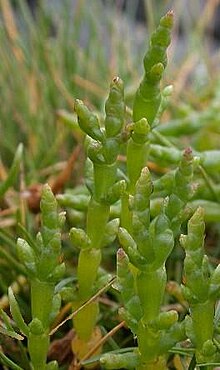Wikipedia
This text was copied from Wikipedia on 25 July 2024 at 6:11AM.
This article needs additional citations for verification. (March 2013) |

Samphire is a name given to a number of succulent salt-tolerant plants (halophytes) that tend to be associated with water bodies.
- Rock samphire (Crithmum maritimum) is a coastal species with white flowers that grows in Ireland, the United Kingdom and the Isle of Man.[1] This is probably the species mentioned by Shakespeare in King Lear.[2]
- Golden samphire (Limbarda crithmoides) is a coastal species with yellow flowers that grows across Eurasia.
- Several species in the genus Salicornia, known as "marsh samphire" in Britain.[3]
- Blutaparon vermiculare, Central America, southeastern North America
- Tecticornia, Australia
- Sarcocornia, cosmopolitan
Following the construction of the Channel Tunnel, the nature reserve created on new land near Folkestone made from excavated rock was named "Samphire Hoe".[2]
Etymology
Originally "sampiere", a corruption of the French "Saint Pierre" (Saint Peter),[4] samphire was named after the patron saint of fishermen because all of the original plants with its name grow in rocky salt-sprayed regions along the sea coast of northern Europe or in its coastal marsh areas. It is sometimes called rock samphire or seafennel. In North Wales, especially along the River Dee's marshes, it has long been known as sampkin.
Uses

Marsh samphire ashes were used to make soap and glass (hence its other old name in English, "glasswort") as it is a source of sodium carbonate, also known as soda ash.[4] In the 14th century glassmakers located their workshops near regions where this plant grew, since it was so closely linked to their trade. Many samphires are edible. In England the leaves were gathered early in the year and pickled or eaten in salads with oil and vinegar. Marsh samphire (Salicornia bigelovii) was investigated as a potential biodiesel source that can be grown in coastal areas where conventional crops cannot be grown.[5]
Rock samphire is another kind of samphire, also called sea fennel. It is mentioned by Shakespeare in King Lear:
Half-way down Hangs one that gathers samphire; dreadful trade!
— Act IV, Scene VI, lines 14–15
This refers to the dangers involved in collecting rock samphire on sea cliffs.
Aboriginal Australians have long used samphire as bush tucker, due to its abundance, flavour, and nutritional value. It is high in Vitamin A and a good source of calcium and iron. Other Australians have recently discovered the potential of the species as a food plant and it has begun to appear on restaurant menus across the country.[6][7]
A variety of rock samphire known as Paccasasso del Conero, or sea fennel,[8] is well known in Italy along the Adriatic coast. This variety is typically used in local recipes such as a mortadella and paccasasso sandwich, pasta with mussels and paccasassi, or in fresh salad.
References
- ^ "Rock Samphire – Identification, Edibility, Distribution". Galloway Wild Foods. 1 July 2013. Retrieved 17 April 2019.
- ^ a b "What's in a name?". Samphire Hoe. Retrieved 17 April 2019.
- ^ "Marsh Samphire – Identification, Edibility, Distribution". Galloway Wild Foods. 17 July 2011. Retrieved 17 April 2019.
- ^ a b "Samphire; A Mermaid's Kiss". Our Norfolk. 6 July 2014. Retrieved 12 August 2014.
- ^ Clark, Arthur (November–December 1994). "Samphire: From Sea to Shining Seed" (PDF). Saudi Aramco World. Saudi Aramco. Archived from the original (PDF) on 26 July 2011. Retrieved 17 November 2008.
- ^ "Samphire". Native tastes of Australia. Retrieved 21 November 2018.
- ^ "Native blackseed samphire". Archived 2020-01-15 at the Wayback Machine. Slow Food in Australia
- ^ "Rinci - Meraviglie di Gusto - Paccasassi del Conero, salse e composte" [Rinci - Wonders of Taste - Paccasassi del Conero, sauces and compotes]. www.rinci.it. 2020. Retrieved 16 October 2022.

3 Annotations
First Reading
Kevin Peter • Link
Definition from hyperdictionary.com
SAMPHIRE
Pronunciation: 'sam`fIr
WordNet Dictionary
Definition: [n] fleshy maritime plant having fleshy stems with rudimentary scalelike leaves and small spikes of minute flowers; formerly used in making glass
Synonyms: glasswort, Salicornia europaea
See Also: genus Salicornia, herb, herbaceous plant, Salicornia
Webster's 1913 Dictionary
Definition: \Sam"phire\ (? or ?; 277), n. [F. l'herbe de Saint
Pierre. See {Saint}, and {Petrel}.] (Bot.)
(a) A fleshy, suffrutescent, umbelliferous European plant
({Crithmum maritimum}). It grows among rocks and on
cliffs along the seacoast, and is used for pickles.
Hangs one that gathers samphire, dreadful trade!
--Shak.
(b) The species of glasswort ({Salicornia herbacea}); --
called in England {marsh samphire}.
(c) A seashore shrub ({Borrichia arborescens}) of the West
Indies.
Pedro. • Link
Rock samphire (Crithmum maritimum).
The cliff-growing rock samphire described in King Lear, in a scene near Dover, has Edgar say to Gloucester, “half way down/Hangs one that gathers samphire, dreadful trade!”
A yellow-flowered perennial, growing chiefly on cliffs and rocks by the sea, and occasionally on shingle beaches. The leaves smell sulphurous when crushed (some people find the scent similar to furniture polish), but it has been used as a vegetable, chiefly in pickles. In the 19C samphire was sent from Dover and the Isle of Wight to London, in casks of brine, where wholesalers would pay up to four shillings a bushel for it.
Flora Britannica by Richard Mabey.
Second Reading
Bill • Link
SAMPHIRE, SAMPIRE. [Minshew derives it of Saint Pierre, St. Peter's Herb] a Plant which generally grows upon rocky Cliffs in the Sea; it is usually pickled and eaten for a dainty Sallet.
---An universal etymological English dictionary. N. Bailey, 1731.